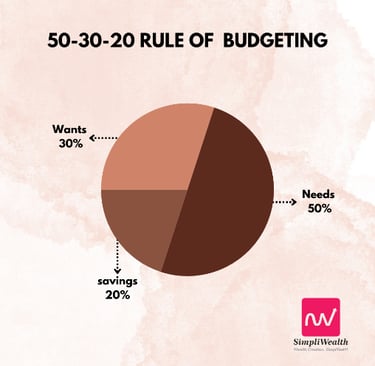Mastering Budgeting Basics: The Rule of 50-30-20 Explained
6/14/20242 min read


Understanding the 50-30-20 Rule
The 50-30-20 rule is a simple yet powerful guideline for managing your finances. According to this rule, you should allocate your after-tax income into three categories:
50% for Needs: This category includes essential expenses such as housing, utilities, groceries, transportation, and healthcare. These are expenses that you cannot avoid and are crucial for your day-to-day living.
30% for Wants: This portion is dedicated to non-essential expenses that enhance your lifestyle. It includes dining out, entertainment, hobbies, and other personal indulgences. While these are not necessities, they contribute to your overall happiness and well-being.
20% for Savings and Debt Repayment: The final category focuses on your financial future. This includes saving for emergencies, retirement, and paying off any debts. Allocating 20% of your income to this category ensures that you are building a solid financial foundation.
Applying the 50-30-20 Rule
To effectively apply the 50-30-20 rule, follow these steps:
Calculate Your After-Tax Income: Determine your total monthly income after taxes. This is the amount you will use to allocate into the three categories.
Track Your Expenses: Keep a record of all your expenses for a month. This will give you a clear picture of where your money is going and help you identify areas where you can cut back.
Allocate Your Income: Based on your tracked expenses, allocate 50% of your income to needs, 30% to wants, and 20% to savings and debt repayment. Adjust your spending habits if necessary to fit within these percentages.
Review and Adjust: Regularly review your budget to ensure you are staying on track. Adjust your allocations as needed to accommodate any changes in your financial situation.
Benefits of the 50-30-20 Rule
Adopting the 50-30-20 rule offers several advantages:
Simplicity: The rule is easy to understand and implement, making it accessible for individuals at any stage of their financial journey.
Flexibility: It provides a flexible framework that can be adjusted to fit your unique financial situation and goals.
Financial Discipline: By categorizing your expenses, you develop better financial habits and discipline, which can lead to long-term financial stability.
Conclusion
Mastering the basics of budgeting is essential for achieving financial success. The 50-30-20 rule offers a straightforward approach to managing your money, ensuring that you cover your needs, enjoy your wants, and secure your financial future. By applying this rule, you can take control of your finances and work towards your financial goals with confidence.
Introduction to Budgeting Basics
Effective budgeting is a cornerstone of financial stability and success. Whether you are an individual or a family, understanding how to allocate your income efficiently can help you achieve your financial goals. One popular and straightforward method to manage your finances is the 50-30-20 budgeting rule. This article will delve into the basics of budgeting and explain how the 50-30-20 rule can simplify the process.
